Information and exercise leaflet for
patients and carers
What is Osteoarthritis?
Osteoarthritis (OA) is a very common condition which can affect any joint in the body. It mainly affects the joints that bear most of our weight and that we use repeatedly in daily life.
Our joints are coated in a smooth, strong tissue called cartilage. Cartilage covers the ends of our bones, allowing the smooth movement of our joints and the absorption of shock during daily activities. Our joints constantly undergo repair in response to everyday use.
In OA the cartilage roughens, reducing it smoothness and ability to absorb shock.
In the early stages of OA the body is able to repair cartilage. This will often allow the joint to work normally, with minimal pain and stiffness. Conversely, in the later stages of OA, pain and stiffness can be severe and disabling. Almost all of us will develop osteoarthritis in some of our joints as we get older with many people not even being aware of it.
Who gets OA?
In over 70% of cases, OA of the ankle results from a previous injury to the joint, which may have occurred in younger life, for example, due to previous fracture, repeated sprained ankles, infection or deformity/alignment faults of the joint.
How do I know if I have OA?
Your doctor can often diagnose OA based a clinical examination and discussion about your symptoms. Tests such as X-rays of the bones or blood tests are usually not needed. Sometimes your doctor may suggest these tests if they are uncertain about the diagnosis and want to exclude other problems.
What are the common symptoms of Osteoarthritis?
- Pain and stiffness are very common symptoms - usually worse first thing in the morning
- Swelling of the joint
- The affected joint may look a little larger than the opposite one
- You may have difficulty walking and may find a walking aid helpful
- The joint may not move very easily – it may feel stiff and restricted
- The joint may make a grating or crackling sounds as you move. This is called crepitus.
- The joint may give way at times if your muscles have become weak
The symptoms of arthritis can vary from week to week, and even from day to day. OA is a long-term condition and knowing how to manage it is very important.
How do I live well with OA?
The aim of physiotherapy is to help you to build your own toolkit of strategies to enable you to care for your joints confidently.
Toolkit:
Exercise
Try to find an activity that you enjoy e.g. swimming, walking or cycling and include this in your weekly routine. Often people worry that exercise could harm their joints and cause more pain. Research has shown however that people who carry out mild to moderate low impact exercise regularly suffer less pain and disability than people who are more sedentary.
Weight control
If you are overweight, try to lose some weight as the extra burden placed on your ankles can make symptoms worse. Weight loss can make quite a difference to the pressure on your joints and help reduce your symptoms. Speak to your physiotherapist about referral to any local weight management programs in your area to support you in your weight loss journey.
Medication
Pin relieving medications can be a useful tool to help you to exercise more and move with fewer symptoms. It is important to discuss with your GP which ones might be appropriate, especially if you are taking any other medication(s).
Walking aids
If you have pain and discomfort in the ankle when walking, a walking stick may help to reduce the pressure on your joint and help you to walk for longer with fewer symptoms. Your physiotherapist can prescribe a walking aid and ensure it is the correct height for you. If possible, hold it in the hand on the opposite side of the body to the affected joint. This helps to take the weight away from your painful ankle.
Ice or Heat
Ice and heat are a safe, effective and cheap way to help to relieve pain or swollen joints. There are many different types of cool packs and heat packs but a simple option is to use a hot water bottle or a packet of frozen peas. Some people alternate between the two or some prefer one more than the other.
Ice is recommended for inflamed joints. If the joint looks swollen and red, it can be applied several times a day for 10 minutes at a time, wrapped in a damp towel.
Participants with reduced sensation, numbness or circulatory problems should discuss the use of ice or heat with a healthcare professional prior to using them.
Ice and heat can burn skin therefore participants should always use a towel to cover the area and check their skin regularly for any changes and signs of burning. A damp towel is more effective when applying ice.
Can I do my normal activities?
Your ankle symptoms can feel better faster if you can maintain your normal level of activity, but you may need to modify what you can do if the pain is not controlled well enough with painkillers. Activity modification rather than activity avoidance is the key to managing your OA. Try to stay active and remember to keep moving. At work, speak to your manager about any concerns you may have.
Activity Modification
It is recommended that you find the ideal level of activity for that helps you to manage your symptoms.
Too much or too little activity can cause symptoms and complete rest is not advised.
“Reaction Rules” are used to help you decide what level of activity is best.
On this scale “0” means no pain at all and “10” means the worst pain imaginable.
It is common to get some reaction or pain with activity. If this is at 5/10 or below (it is an acceptable level of discomfort) and settles within 24 hours, you are doing an appropriate amount and may be able to gradually increase it over time.
If the pain is above a 5/10 and/or doesn’t settle within 24 hours, you are likely doing too much and will need to reduce your activities. Once symptoms settle, gradually build up your activity keeping within the green zones (0-5/10). Remember, these activity levels aren’t just for today, you should take into account the average of your activity over the week.
Warning Signs
If you develop new or worsening symptoms, if you are unwell with the pain, or under the age of 16 years, seek medical advice.
The following symptoms are very rare, but if you suddenly develop any of them, you should seek urgent medical attention at your local Urgent Care Centre.
- Sudden onset of Achilles pain, with a “pop” or snapping sound/sensation.
- Inability to weight-bear through the foot/ankle.
- New significant injury to the leg/foot/ankle.
- Constant night pain in the foot/ankle (that prevents rest/sleep).
- Significant swelling, colour change or temperature change in the foot/ankle or extending up the leg.
- Lumps in the foot/ankle.
- Signs of infection i.e. night sweats that are out of the ordinary, high temperature and feeling unwell.
- Unexplained weight loss
If your symptoms fail to improve within 6-8 weeks with this regime you should contact your doctor for a physiotherapy referral.
If your symptoms are improving (even slowly), continue for up to 3 months.
Exercises for OA Ankle
Do not work into pain but it is OK for your muscles to feel tired. If the number of repetitions or length of the hold is too long, back off slightly, but aim to build up to the stated level.
Use the reaction rules to guide your exercise intensity. If pain is stopping you engaging in rehab, you should speak to your GP about pain relief promptly.
Flare-ups may happen; if pain doesn’t settle in a couple of weeks, then seek further advice
Level 1 – start off with low numbers of the exercise and gradually build up your hold time or your repetitions.
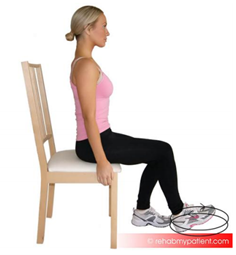
Ankle Circles Sitting
Sit down, and move your ankles around in circles both anti-clockwise and clockwise. This is a great mobility exercise to the ankle, and very useful for ankle stiffness following a sprain.
Repeat for 30 seconds Repeat twice 2 times daily

Heel Raises Sitting
Sit upright on a chair, with your feet flat on the floor. Slowly raise your legs up onto your toes. Hold, and gradually control the movement back down to the starting position. This is a useful calf pump exercise to improve circulation to your lower legs, as well as improving mobility of the ankle joints.
Repeat for 5-10 seconds Repeat times 10 2 times daily
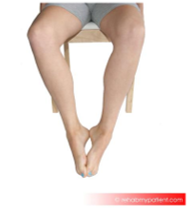
Resisted Inversion
In sitting, place your toes together, pressing inwards and upwards against the resistance of each other. This is a strengthening exercise for the ankle.
Repeat for 10-20 seconds Repeat times 3 2 times daily
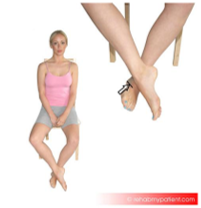
Self Resisted Eversion
Sitting on a chair, cross your feet keeping your heels on the floor. Push the outside of your feet against each other. This is a strengthening exercise for your ankles.
Repeat for 10-20 seconds Repeat times 3 2 times daily
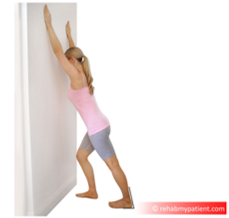
Gastrocnemius Stretch – Single Leg
Stand facing a wall, with your hands resting on the wall. Move one leg forwards and gently bend your knee, this will be the passive leg and just there for support. The leg you will be stretching will remain straight with your heel on the ground and a doorstop wedge under the ball of your foot, the thickest side under the big toe side and the thin end under the little toe side. You should feel a stretch to the leg at the back, in the calf muscle (known as the gastrocnemius).
Repeat for 30 seconds Repeat times 3 2 times daily
Level 2 – If exercies at level 1 feel easy to complete you can try the following exercises – ensure you have something to hold onto for balance and to prevent falls.
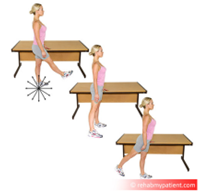
One Leg Clocks
Stand on your injured leg. Swing your other at different directions, as if you were going around a clock. Hold onto support if required. This exercise challenges the injured leg that stabilises the body while your non-injured leg moves in different directions.
Practice for 30 seconds Repeat times 3 2 times daily

Calf Raises Two Legs
Stand upright and hold onto a wall/table for balance if required. Slowly raise up onto your toes and control the movement back down. This exercise will strengthen the calf muscles and ankle joints.
Hold for 5-10 seconds Repeat times 5 2 times daily
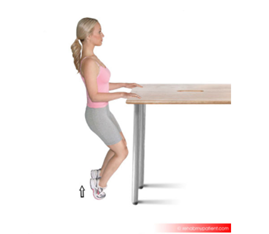
Calf Raises with knees bent
Stand up with your knees bent and rise up onto your toes and hold. Slowly control the movement back down. This is a strengthening exercise for the soleus (lower calf) muscle.
Hold for 5-10 seconds Repeat times 5 2 times daily
What actions can I take to improve my health?
Evidence tells us that making healthy lifestyle choices can have a big impact on influencing problems with your muscles and bones and can play a major role in your overall health. Some of the most effective areas to address are below: (click on the links)
Maintaining a healthy weight - www.nhs.uk/live-well/healthy-weight/
Increasing levels of physical activity - http://www.nhs.uk/live-well/exercise/
Avoiding poor sleep patterns - www.nhs.uk/live-well/sleep-and-tiredness/how-to-get-to-sleep/
Reducing alcohol consumption - https://www.nhs.uk/live-well/alcohol-support/calculating-alcohol-units/
Stopping smoking - http://www.nhs.uk/live-well/quit-smoking/
Maintaining a healthy mind - http://www.nhs.uk/conditions/stress-anxiety-depression/
The good news is that you are able to influence lots of these by modifying your lifestyle. Therefore it is important that you consider addressing these areas alongside your current treatment.
You may wish to discuss any of these factors with your treating clinician who will be able to work with you and guide your long term management and support you to improve your wellbeing.
There will be information about the local services that exist within the waiting areas of the physiotherapy department and your treating clinician will be able to help signpost you to appropriate services.
The websites listed below give more information on local services available:
• Blackburn and Darwen - https://refreshbwd.com/
• East Lancashire - http://www.upandactive.co.uk/
• Public Health England https://www.gov.uk/government/organisations/public-health- england
You can download a printable version of this information here.
Please note this is a PDF and does not meet accessibility needs.


